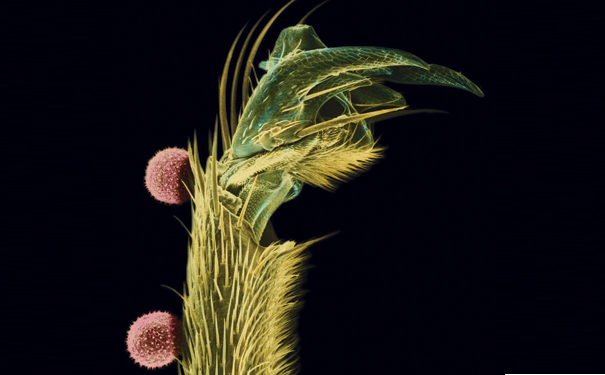
Two pollen grains of a high mallow flower are attached to a bumblebee's leg. Image: Rob Kessler and Madeline Harley
December 2, 1989, a private twin-engine plane travelling from San Diego in the US crashed near a regional airport in Ruidoso, New Mexico, killing the pilot and his wife.
Investigators found no defects in the engines and attributed the crash to pilot error before storing the wreckage in a yard outside the airport. Attorneys for the children of the couple later salvaged some of the plane parts and conducted their own investigation, turning up a small mass of plant matter in one engine’s fuel lines. They sued the plane’s manufacturers, asserting that the engine sucked in the vegetation during the aircraft’s flight or approach, clogging the fuel line and causing power loss. Filters, they claimed, would have prevented the crash.
In an unusual move, the defence attorneys called in palynologists — experts on pollen and spores — to pinpoint the origin of the mass, which included plant leaves and hairs and a small pellet of pollen grains. Did the vegetation enter the fuel line when the plane was airborne, or later, when the wreckage was stored outside? The experts analysed the grains under high magnification and identified them mainly as yellow sweetclover and curlycup gumweed, two insect-pollinated flowers that grew in the yard where the plane parts had been stored.
Hardly any pollen would have been in the air during the winter when the crash took place, let alone insect-dispersed pollen, which is heavier than grains carried by the wind and is scarce at high altitudes. Plus, the pollen was fresh and intact, showing no signs of being burned in a fiery crash. The possibility that the matter had entered the motor in-flight was ruled out, and the defendants were exonerated. The source of the plant mass: a rogue bee that had taken up residence in the engine after the crash, leaving a telltale hair embedded in the pollen.
Suspended in clouds, fossilised inside ancient rocks, hidden in the lint in your pants pockets — pollen is everywhere. Some 240,000 described species of flowering and coniferous plants produce the fine dust — many in huge quantities — yet single grains are invisible to the naked eye. Their diverse beauty is revealed best in scanning-electron-microscope images like those on these pages, magnified thousands of times and hand-coloured. Pollen’s shapes and adornments fulfill a practical purpose, researchers theorise. Each grain is designed to help the male reproductive cells inside it find their way, whether on wind, water or animals, to female parts of the same species, and stay there. Yet lately pollen has begun to play a very different role — as a sophisticated form of forensic evidence.














